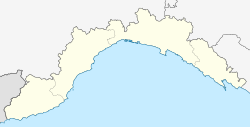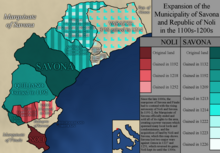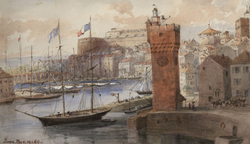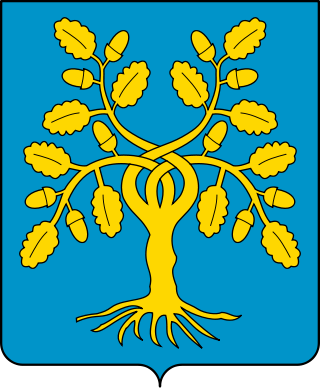
The House of Della Rovere was a powerful Italian noble family. It had humble origins in Savona, in Liguria, and acquired power and influence through nepotism and ambitious marriages arranged by two Della Rovere popes: Francesco Della Rovere, who ruled as Sixtus IV from 1471 to 1484 and his nephew Giuliano, who became Julius II in 1503. Sixtus IV built the Sistine Chapel, which was named after him. Julius II was patron to Michelangelo, Raphael and many other Renaissance artists and started the modern rebuilt of St. Peter's Basilica. Also the Basilica of San Pietro in Vincoli in Rome was the family church of the Della Rovere. Members of the family were influential in the Church of Rome, and as dukes of Urbino, dukes of Sora and lords of Senigallia; the title of Urbino was extinguished with the death of Francesco Maria II in 1631, and the family died out with the death of his granddaughter Vittoria, Grand Duchess of Tuscany.

Liguria is a region of north-western Italy; its capital is Genoa. Its territory is crossed by the Alps and the Apennines mountain range and is roughly coextensive with the former territory of the Republic of Genoa. Liguria is bordered by France to the west, Piedmont to the north, and Emilia-Romagna and Tuscany to the east. It rests on the Ligurian Sea, and has a population of 1,557,533. The region is part of the Alps–Mediterranean Euroregion.

La Spezia is the capital city of the province of La Spezia and is located at the head of the Gulf of La Spezia in the southern part of the Liguria region of Italy.

Ventimiglia is a resort town in the province of Imperia, Liguria, northern Italy. It is located 130 km (81 mi) west of Genoa, and 7 km (4.3 mi) from the French-Italian border, on the Gulf of Genoa, having a small harbour at the mouth of the Roia river, which divides the town into two parts. Ventimiglia's urban area has a population of 55,000.

Noli is a coast comune of Liguria, Italy, in the Province of Savona, it is about 50 kilometres (31 mi) southwest of Genoa by rail, about 4 metres (13 ft) above sea-level. The origin of the name may come from Neapolis, meaning "new city" in Greek.

Albissola Marina is a comune (municipality) in the Province of Savona in the Italian region Liguria, located about 35 kilometres (22 mi) west of Genoa and about 4 kilometres (2.5 mi) northeast of Savona.

Albisola Superiore is a comune (municipality) in the Province of Savona in the Italian region Liguria, located about 35 kilometres (22 mi) southwest of Genoa and about 5 kilometres (3 mi) northeast of Savona.

Celle Ligure is a comune (municipality) in the Province of Savona in the Italian region Liguria, located about 30 kilometres west of Genoa and about 8 kilometres northeast of Savona.
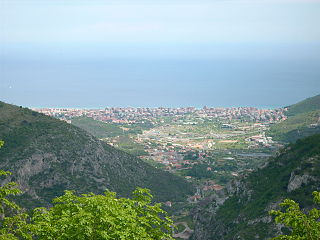
Loano is a comune (municipality) in the Province of Savona in the Italian region Liguria, located about 60 kilometres (37 mi) southwest of Genoa and about 30 kilometres (19 mi) southwest of Savona.

Sassello is a comune (municipality) in the Province of Savona in the Italian region Liguria, located about 58 kilometres (36 mi) west of Genoa and about 26 kilometres (16 mi) north of Savona in the northern side of the Ligurian Apennines. It is the birthplace of Blessed Chiara Badano.

The Diocese of Savona-Noli is a Latin diocese of the Catholic Church in northern Italy. It was historically the Diocese of Savona, from the tenth century. In 1820 the Diocese of Noli was united to the Diocese of Savona. It is a suffragan of the Archdiocese of Genoa.

The Diocese of Ventimiglia-Sanremo is a Latin diocese of the Catholic Church in Liguria, northern Italy. The name of the historic Diocese of Ventimiglia was changed in 1975. It was originally a suffragan diocese of the Metropolitanate of Milan up to 1806, when it was transferred to the Metropolitanate of Aix; but it has been a suffragan of the Archdiocese of Genoa since 1818.

The Diocese of Albenga–Imperia is a Latin diocese of the Catholic Church in Liguria, northern Italy; the traditional name of the Diocese of Albenga was changed by decree of the Congregation of Bishops in the Roman Curia, with the approval of Pope Paul VI, on 1 December 1973. It is a suffragan of the Archdiocese of Genoa.
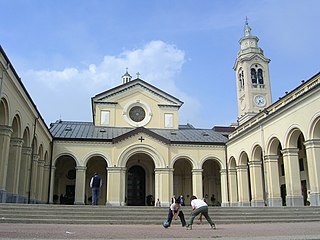
The Shrine of Nostra Signora della Guardia is a Roman Catholic place of pilgrimage located on the top of Monte Figogna in the Municipality of Ceranesi, about 20 kilometres from the city of Genoa, in the northwest of Italy.

The Delle Piane family is an old Genoese noble family first recorded in Polcevera in 1121. Over the past ten centuries it has produced many distinguished government officials, clerics, diplomats, soldiers and patrons.

The Priamar Fortress is a fortress occupying the hill with the same name above the port of Savona, Liguria, northern Italy.

Imperia is a coastal city and comune in the region of Liguria, Italy. It is the capital of the Province of Imperia, and historically it was capital of the Intemelia district of Liguria. Benito Mussolini created the city of Imperia on 21 October 1923 by combining Porto Maurizio and Oneglia, as well as the surrounding village communes of Piani, Caramagna Ligure, Castelvecchio di Santa Maria Maggiore, Borgo Sant'Agata, Costa d'Oneglia, Poggi, Torrazza, Moltedo and Montegrazie.

The Archaeological Museum of Savona is located in Palazzo della Loggia inside the Priamar Fortress. It presents the history of the Priamar promontory and the town of Savona. On the exposition are old collections of objects from around the Mediterranean and artifacts from the 20th century excavations of the fortress and its surrounding. The museum has two floors and inside it is possible to see original excavation pits.

Genoa is a city in and the capital of the Italian region of Liguria, and the sixth-largest city in Italy. In 2023, 558,745 people lived within the city's administrative limits. While its metropolitan city has 813,626 inhabitants, more than 1.5 million people live in the wider metropolitan area stretching along the Italian Riviera.
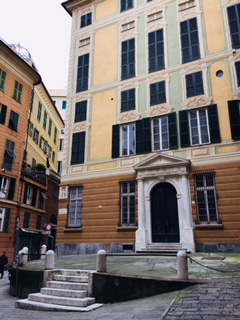
The Palazzo Clemente della Rovere is a palace located in Piazza Rovere in the historical center of Genoa, Northwestern Italy. The palace was one of the 163 Palazzi dei Rolli of Genoa, the selected private residences where the notable guests of the Republic of Genoa were hosted during State visits. On 13 luglio 2006 it was added to the list of 42 palaces which now form the UNESCO World Heritage Site Genoa: Le Strade Nuove and the system of the Palazzi dei Rolli. The palace hosts today the General Consulate of Iceland.






